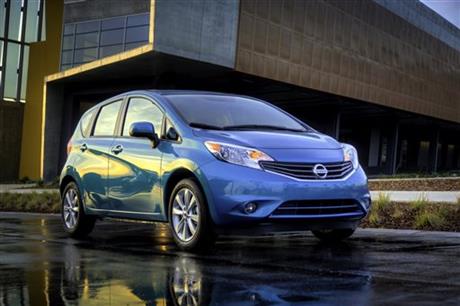
By ANN M. JOB
This undated product image provided by Nissan shows the all-new Versa Note. The five-seat Versa Note is a low-priced, high-utility car with an attractive, fresh exterior, notable fuel economy and a surprisingly roomy back seat that accommodates even 6-foot adults. (AP Photo/Nissan)
Nissan’s small Versa hatchback, renamed the Versa Note for 2014, is a low-priced, high-utility car with an attractive, fresh exterior, notable fuel economy and a surprisingly roomy back seat that accommodates even 6-foot adults.
The five-seat Versa Note also offers high-tech features not found in other hatchbacks, such as an all-around-view camera system that lets the driver see what is nearby the car on all four sides.
Drivers will appreciate that the Note with its 109-horsepower, four-cylinder engine is rated by the federal government at 31 miles per gallon in city driving and 40 mpg on the highway. This top rating is for Notes equipped with a fuel-thrifty continuously variable transmission (CVT).
Unfortunately, though, the Versa Note’s engine power is lower than many competitors’.
And while the Note is a new version of Nissan’s Versa line, the Note’s safety rating in frontal crash testing by the federal government isn’t any better than the three out of five stars that the longer-running Versa sedan received.
Standard safety features on all Notes include frontal, side and curtain air bags, antilock brakes and electronic stability control.
Starting manufacturer’s suggested retail price, including destination charge, of $14,800 for a base, 2014 Note is lower than many competitors’. As an example, the base, 2013 Honda Fit hatchback has a starting retail price of $16,215.
But be aware that the base Versa Note S comes with five-speed, manual transmission that produced a lower government fuel mileage rating of 27/36 mpg. The base Note also has manual, roll-down windows and a steering wheel that tilts but does not telescope.
In comparison, the base Fit with five-speed manual and higher-power, 117-horsepower, four-cylinder engine comes standard with power windows, a tilt and telescoping steering wheel and cruise control, among other things.
Meantime, the 2014 Ford Fiesta hatchback, which is 3 inches shorter in overall length than the Note, has a starting MSRP, including destination charge, of $15,395 with five-speed manual and 120-horsepower, four-cylinder engine.
The base Fiesta comes standard with telescoping and tilt steering wheel, rear spoiler, Ford’s Sync voice control, carpeted floor mats and a driver’s seat with six-way, manual adjustment rather than the four-way, manual adjustment on the Note.
For Note buyers to get the fuel-saving CVT, which comes along with automatic grille shutter that closes when needed to improve aerodynamics and fuel mileage, they must move up to the Versa Note S Plus, with a starting retail price of $16,050.
People must experience the Note’s back seat to believe it.
Less than 14 feet long and about the size of a Fit hatchback, the Note has 38.3 inches of legroom back there. It’s enough to allow 6-footers to extend their legs. It’s also nearly 4 inches more than the Fit has, 1.1 inches more than the Ford Fiesta hatchback has and is even more back-seat legroom than is found in the much larger Nissan Altima mid-size sedan.
Front-seat passengers in the Versa Note aren’t squeezed, either, as legroom up there totals 41.3 inches, which is on par with some sport utility vehicles.
Just keep in mind that while two adults in back do well, three people in the back of a Note is tight. Still, back windows in the Note are sizable and go down virtually the whole way.
Also improving comfort in the Note: Passengers don’t sit low to the ground. Even back-seat riders sit up at a decent level and have good views out.
But the seat foam in the test SV model had a cheap feel and was less supportive than preferred. This was especially true as road bumps came through regularly in the Note, and ripples in asphalt were felt, and not just in the seat cushions but up to passengers’ backs.
The ride in the test Note was noisy. Road and engine sounds were heard all the time, and the CVT kept the driver guessing when engine revving would quiet down.
The Note’s 1.6-liter, double overhead cam four cylinder was lackluster during acceleration and seemed to work hard during highway merges. Torque peaks at 107 foot-pounds at 4,400 rpm. This compares with 112 foot-pounds at 5,000 rpm for the Fiesta’s 1.6-liter four cylinder and the Fit’s 106 foot-pounds at 4.800 rpm.
The Note’s commendable fuel economy ratings are not far-fetched. In mostly city driving, the tester averaged 30 mpg, just 1 mpg off from the federal government number. And this was without the driver focusing on top mileage. Fuel mileage was 32 mpg with highway travel added.
Because the Note is 5 feet tall, it affords front-seat passengers a generous 40.8 inches of headroom, which is more than the 39.1 inches in the Fiesta hatchback and a tad more than the 40.4 inches in the front seats of the Fit.
The cargo area behind the rear seats provides 18.8 cubic feet of space, which compares with 14.9 cubic feet in the Fiesta and the 21.6 cubic feet in the Fit.
According to the federal government, the Note has better side crash performance — five out of five stars — than the Versa sedan’s four out of five stars. Overall crash rating, including rollover propensity, for the Note is four out of five stars, which is the same as for the 2013 Honda Fit.
In July, there were two safety recalls for the 2014 Versa Note.
Nissan recalled certain Versa Notes because back-seat bolts may break in a crash, which could increase the risk of injuries to rear-seat passengers.
Nissan also recalled some cars because lower body bolts might be missing or improperly tightened. This could impair vehicle integrity during a rear-end crash and increase the risk of passenger injury.



